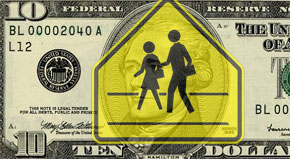It’s The Final Day Of The Back To School Sales Tax Holiday
August 7, 2016
Parents and other shoppers looking for tax breaks on clothes and school supplies are heading to the stores this weekend.
While Florida’s back-to-school sales tax “holiday” has been scaled back from last year, a major retail-industry organization said it anticipates a rush of traffic for the event, which through midnight Sunday.
“What we hope they do is take the money they saved on those items, then go back in and buy secondary items that they wouldn’t have purchased originally,” Florida Retail Federation spokesman James Miller said. “The smart retailers will piggyback on top of the sales-tax holiday with extra specials and discounts to get more people into the stores, make themselves more competitive and separate themselves from the competition.”
The tax holiday was spread over 10 days last year. But as the 2016 legislative session came to an end, it was among the casualties of lawmakers responding to state economists who reduced revenue forecasts.
In addition to fewer days for this year’s tax holiday, computers and other electronics are not on the tax-free list as has been the case the past four years.
Also, each item of clothing costing $60 or less this year will be tax free. That has been lowered from a $100 threshold last year and $75 in some previous years.
Items considered school supplies remain tax free if priced at $15 or less.
For a more complete list, click here.
 The holiday is a highlight of a $129.1 million tax-cut package that lawmakers approved this year. Lawmakers have touted $400 million in tax savings because of money they approved to hold down local property taxes that would otherwise go into the state’s school-funding formula.
The holiday is a highlight of a $129.1 million tax-cut package that lawmakers approved this year. Lawmakers have touted $400 million in tax savings because of money they approved to hold down local property taxes that would otherwise go into the state’s school-funding formula.
The tax holiday is projected by state economists to save $28.7 million for consumers while reducing government revenue. That includes $23.3 million of state revenue and $5.4 million local-government revenue.
The state has held tax holidays most years since 1998. Until 2010, the length was often nine days. Other than the 10-day holiday last year, the length has been three days since 2010.
When initially proposed this year as a 10-day discount period, state economists projected the savings to consumers at $68.8 million.
The holiday comes with a number of carve-outs.
The tax must still be collected on clothing and other items, regardless of price, purchased at theme parks, airports or public-lodging establishments. Watches and jewelry don’t count as clothes. Skates, roller blades and swim fins are not included as tax-free footwear.
The retail federation projects that a typical family will spend $673 this year on back-to-school shopping, up from $640 a year ago.
Miller called that hike a “pretty significant” year-to-year increase.
“The economy is doing well, people are feeling better about themselves,” Miller said. “You combine that with high consumer confidence, a good housing market, a seven-year-low in the unemployment rate, all these factors are making people feel more confident about themselves and about their personal finances, which is allowing them to feel more comfortable spending their money.”
by Jim Turner, The News Service of Florida



Comments